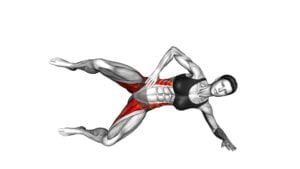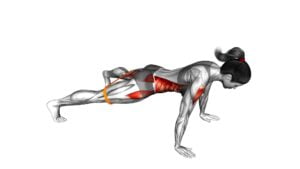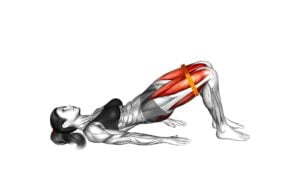Resistance Band Side Plank Glute Raise (female) – Video Exercise Guide & Tips

Are you ready to sculpt and strengthen your glutes? Look no further than the resistance band side plank glute raise.
Watch This Exercise Video
This exercise targets your glute muscles, helping you achieve a toned and lifted booty.
With just a resistance band and a mat, you can easily perform this exercise at home or in the gym.
Watch the video guide for proper form and technique, and get ready to feel the burn in your glutes!
Key Takeaways
- Resistance band side plank glute raise targets and tones the glute muscles for a lifted booty.
- The use of a resistance band increases intensity and activates the glutes more effectively.
- Engaging the core muscles during the exercise improves stability and balance.
- Modifications can be made to suit different fitness levels, and different equipment options can be used, such as ankle weights or a stability ball.
Benefits of Resistance Band Side Plank Glute Raise
To maximize your results and strengthen your glutes, incorporating the resistance band into your side plank will provide you with an effective and challenging workout.
The benefits of the resistance band side plank glute raise are numerous. Firstly, this exercise targets your glute muscles, helping to tone and shape your backside. By adding the resistance band, you increase the intensity of the exercise, making it more challenging and activating your glutes even more.
Not only does this exercise help to strengthen your glutes, but it also engages your core muscles, improving your overall stability and balance. Additionally, the resistance band can be easily modified to suit your fitness level. If you're a beginner, you can start with a lighter resistance band and gradually increase the resistance as you become stronger. For those looking for a greater challenge, you can progress to using a thicker resistance band or adding ankle weights.
By incorporating the resistance band into your side plank glute raise, you'll experience enhanced muscle activation and see greater results in your glute strength and tone.
Now, let's move on to discuss the equipment needed for this exercise.
Equipment Needed for Resistance Band Side Plank Glute Raise
To perform the Resistance Band Side Plank Glute Raise exercise, you'll need a few essential pieces of equipment.
The first is a resistance band, which will provide the necessary resistance to target your glute muscles effectively. It's recommended to choose a resistance band that matches your fitness level, ensuring that it provides enough challenge without causing strain.
If you don't have a resistance band, you can try using alternative equipment like ankle weights or a stability ball to achieve similar results.
Essential Equipment for Glute Raise
You'll frequently need a resistance band for the glute raise exercise. This essential equipment helps to add resistance and increase the intensity of the workout, targeting your glute muscles effectively.
The resistance band provides a continuous tension throughout the movement, engaging your glutes to work harder. It also allows for a greater range of motion, enabling you to fully activate your glute muscles.
When choosing a resistance band, opt for one that provides enough resistance to challenge you without compromising your form. Make sure it's durable and secure to prevent any accidents during your workout.
Investing in a quality resistance band will enhance your glute raise exercise and help you achieve your fitness goals faster.
Recommended Resistance Band
For the resistance band side plank glute raise, you'll need a suitable resistance band that provides enough challenge without compromising your form. When choosing the best resistance band for this exercise, consider your fitness level and the level of resistance you can handle.
There are different types of resistance bands available, such as loop bands, tube bands, or flat bands. Loop bands are great for targeting specific muscle groups, while tube bands offer more versatility in terms of resistance levels. Flat bands are ideal for exercises that require a wider range of motion.
It's important to choose a resistance band that feels comfortable and allows you to perform the exercise with proper technique. Experiment with different resistance bands to find the one that works best for you and helps you achieve your fitness goals.
Alternatives to Resistance Bands?
If you don't have access to resistance bands, there are alternative equipment options you can use for the resistance band side plank glute raise exercise. Don't worry, you can still get a great workout without them! Here are four alternatives to resistance bands that you can try:
- Dumbbells: Hold a dumbbell in your top hand while performing the side plank glute raise to add resistance and challenge your muscles.
- Kettlebell: Place a kettlebell on your top hip as you lift your leg during the exercise. This will increase the difficulty and engage your glutes even more.
- Medicine ball: Rest the medicine ball on your top hip for added resistance. This will help to target your glutes and challenge your stability.
- Ankle weights: Strap on some ankle weights to increase the intensity of the exercise and target your glutes more effectively.
Proper Form and Technique for Resistance Band Side Plank Glute Raise
To perform the Resistance Band Side Plank Glute Raise with proper form and technique, there are a few key points to keep in mind.
First, ensure your hips are aligned and stacked on top of each other to maintain stability throughout the exercise.
Engage your core muscles by drawing your belly button in towards your spine, which will help to stabilize your body and protect your lower back.
Lastly, don't forget to adjust the tension of the resistance band to a level that challenges you without compromising your form.
Hip Alignment Tips
Achieving proper hip alignment is crucial for performing the Resistance Band Side Plank Glute Raise with proper form and technique. To ensure your hips are aligned correctly, follow these tips:
- Engage your core: A strong core helps stabilize your hips and maintain proper alignment.
- Activate your glutes: Strengthening your glute muscles will help you maintain stability and prevent your hips from sagging or rotating.
- Maintain a straight line: Your body should form a straight line from your head to your heels, with your hips stacked on top of each other.
- Avoid hip sagging or rotation: Keep your hips lifted and square throughout the exercise to maximize its effectiveness.
By focusing on these hip alignment tips, you won't only improve the effectiveness of the Resistance Band Side Plank Glute Raise but also reduce the risk of injury and enhance your overall strength and stability.
Keep up the great work!
Engaging Core Muscles
To engage your core muscles properly during the Resistance Band Side Plank Glute Raise, tighten and activate your abdominal muscles. This is crucial for maintaining stability and preventing any strain or injury.
Start by lying on your side with your forearm on the ground and your feet stacked on top of each other. Place the resistance band just above your knees.
As you lift your hips off the ground, focus on contracting your core muscles. Imagine pulling your belly button towards your spine. This will help to stabilize your torso and maintain a strong and aligned position.
Maintaining an engaged core throughout the exercise won't only enhance the effectiveness of the glute raise but also improve your overall strength and stability.
Keep practicing these core activation techniques to maximize your results.
Band Tension Adjustments
Continuing from engaging your core muscles, adjust the band tension for the Resistance Band Side Plank Glute Raise by positioning it at a level that challenges your glutes without straining your body.
Here are four band tension modifications and resistance band variations to maximize the effectiveness of this exercise:
- Increase the tension by using a thicker resistance band or by doubling up on bands.
- Decrease the tension by using a thinner resistance band or by loosening the band slightly.
- Experiment with different band placements, such as above the knees or around the ankles, to target different glute muscles.
- Incorporate lateral band walks or resistance band squats to further engage your glutes and add variety to your workout.
Modifications and Progressions for Resistance Band Side Plank Glute Raise
For modifications and progressions of the Resistance Band Side Plank Glute Raise, try incorporating different levels of resistance bands. By using bands with varying levels of resistance, you can challenge your glutes and core muscles in different ways. For beginners, using a lighter resistance band can help you focus on your form and build strength. As you become more advanced, you can increase the resistance by using a heavier band. This will intensify the workout and target your glutes even more.
To further progress this exercise, you can also try adding a pulse at the top of the glute raise or extending your top leg straight out in front of you. These modifications will engage your muscles in new ways and provide an extra challenge. Remember to always listen to your body and start with a resistance band that feels comfortable for you.
As you get stronger, don't be afraid to challenge yourself and increase the resistance to continue progressing. Keep pushing yourself and you'll see improvements in your glute strength and stability.
Common Mistakes to Avoid During Resistance Band Side Plank Glute Raise
One common mistake to avoid during the Resistance Band Side Plank Glute Raise is allowing your hips to sag towards the ground. Proper form is crucial for maximizing the effectiveness of this exercise and preventing injury.
Here are four common mistakes to watch out for and tips on how to correct them:
- Sagging Hips: Keep your hips lifted and in line with your body throughout the entire exercise. Engage your core and glutes to maintain stability and prevent your hips from dropping.
- Lifting the Leg Too High: While it may be tempting to lift your leg as high as possible, avoid excessive range of motion. Lift your leg only until it's parallel to the ground, focusing on squeezing your glutes at the top of the movement.
- Not Engaging the Core: Your core muscles play a crucial role in stabilizing your body during the exercise. Remember to engage your abs by pulling your belly button towards your spine, creating a strong and stable foundation.
- Using Too Much Resistance: Start with a resistance band that challenges you but allows you to maintain proper form. Using a band that's too strong may cause you to sacrifice technique and put unnecessary strain on your muscles.
Tips for Getting the Most Out of Resistance Band Side Plank Glute Raise
To maximize the effectiveness of the Resistance Band Side Plank Glute Raise, focus on engaging your core and glutes while maintaining proper form. This exercise targets your glute muscles, hip stability, and core strength. Here are some tips to help you get the most out of this exercise.
First, make sure to keep your body in a straight line from your head to your heels. Avoid sagging or arching your back, as this can put unnecessary strain on your lower back. Engage your core muscles by pulling your belly button in towards your spine, and squeeze your glutes as you lift your leg.
Next, pay attention to your hip stability throughout the movement. Keep your hips stacked on top of each other and avoid letting your top hip drop towards the ground. This will help to strengthen your hip stabilizer muscles and improve your balance.
If you want to challenge yourself further, there are advanced variations you can try. You can add a resistance band around your ankles or knees to increase the resistance and engage your glutes even more. You can also try lifting your top leg higher or holding the raised position for a few seconds to intensify the exercise.
Remember to listen to your body and start with a resistance level that's appropriate for your fitness level. As you become more comfortable with the exercise, gradually increase the intensity and challenge yourself with advanced variations. Stay consistent and you'll see improvements in your glute strength and hip stability.
Keep up the good work!
Frequently Asked Questions
How Many Calories Does the Resistance Band Side Plank Glute Raise Burn?
Resistance Band Side Plank Glute Raise is a challenging exercise that targets multiple muscles, including the glutes, core, and shoulders. While it's difficult to determine the exact number of calories burned during this exercise, it can be an effective way to increase your heart rate and burn calories.
Additionally, variations of this exercise, such as adding more resistance or increasing the duration, can further enhance the calorie-burning potential. Remember to incorporate this exercise into a well-rounded fitness routine for optimal results.
Can Men Also Perform the Resistance Band Side Plank Glute Raise Exercise?
Yes, men can also perform the resistance band side plank glute raise exercise. It's a great addition to your men's fitness routine as it targets multiple muscle groups, including the glutes and core.
The side plank exercise itself has various variations, and using a resistance band adds an extra challenge and helps increase strength and stability.
Is It Safe to Do the Resistance Band Side Plank Glute Raise if You Have a Lower Back Injury?
If you have a lower back injury, it's important to take safety precautions when considering the resistance band side plank glute raise exercise. Make sure to consult with a healthcare professional or a certified trainer before attempting this exercise. They can provide modifications and alternatives that can help protect your lower back while still targeting your glutes effectively.
Prioritizing your safety and listening to your body's cues will ensure a safe and effective workout routine.
How Often Should I Perform the Resistance Band Side Plank Glute Raise for Optimal Results?
To get optimal results from the resistance band side plank glute raise, you should focus on frequency. It's important to perform this exercise regularly, but also give your muscles time to recover. Aim to do it 2-3 times a week, allowing at least a day of rest in between sessions.
Consistency is key! Also, be mindful of common mistakes like not engaging your core or using improper form.
Stay motivated and make the most out of this exercise!
Can I Use a Different Type of Resistance Band for the Exercise if I Don't Have the Recommended One?
If you don't have the recommended resistance band for the exercise, don't worry! There are different types of resistance bands that you can use as alternatives. Look for bands with similar resistance levels to ensure you get a good workout.
You can also modify the exercise by using a looped resistance band around your thighs instead of a band around your ankles. Remember, the key is to challenge your glutes and core muscles, so find a band that works for you and keep pushing yourself!
Conclusion
The resistance band side plank glute raise is a challenging exercise that targets the glutes, core, and shoulders. By incorporating resistance bands, you can increase the intensity and engage your muscles even more.
Remember to maintain proper form and technique to maximize the benefits of this exercise.
Don't forget to modify or progress the exercise based on your fitness level. Avoid common mistakes and follow these tips to make the most out of your resistance band side plank glute raise and achieve your fitness goals.

Author
Years ago, the spark of my life’s passion ignited in my mind the moment I stepped into the local gym for the first time. The inaugural bead of perspiration, the initial endeavor, the very first surge of endorphins, and a sense of pride that washed over me post-workout marked the beginning of my deep-seated interest in strength sports, fitness, and sports nutrition. This very curiosity blossomed rapidly into a profound fascination, propelling me to earn a Master’s degree in Physical Education from the Academy of Physical Education in Krakow, followed by a Sports Manager diploma from the Jagiellonian University. My journey of growth led me to gain more specialized qualifications, such as being a certified personal trainer with a focus on sports dietetics, a lifeguard, and an instructor for wellness and corrective gymnastics. Theoretical knowledge paired seamlessly with practical experience, reinforcing my belief that the transformation of individuals under my guidance was also a reflection of my personal growth. This belief holds true even today. Each day, I strive to push the boundaries and explore new realms. These realms gently elevate me to greater heights. The unique combination of passion for my field and the continuous quest for growth fuels my drive to break new ground.







